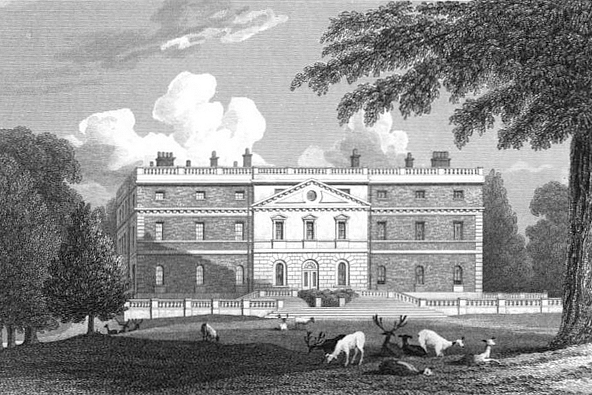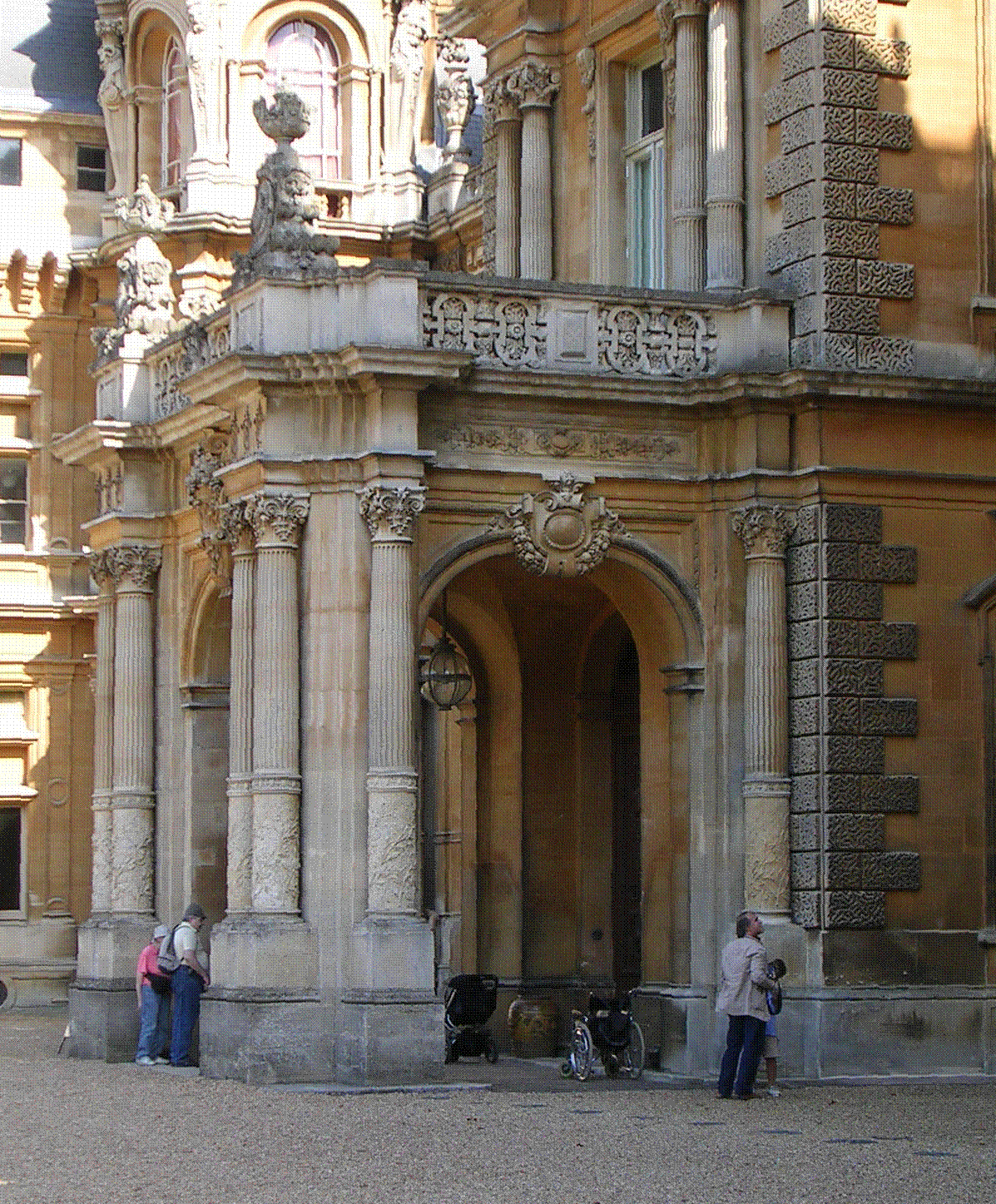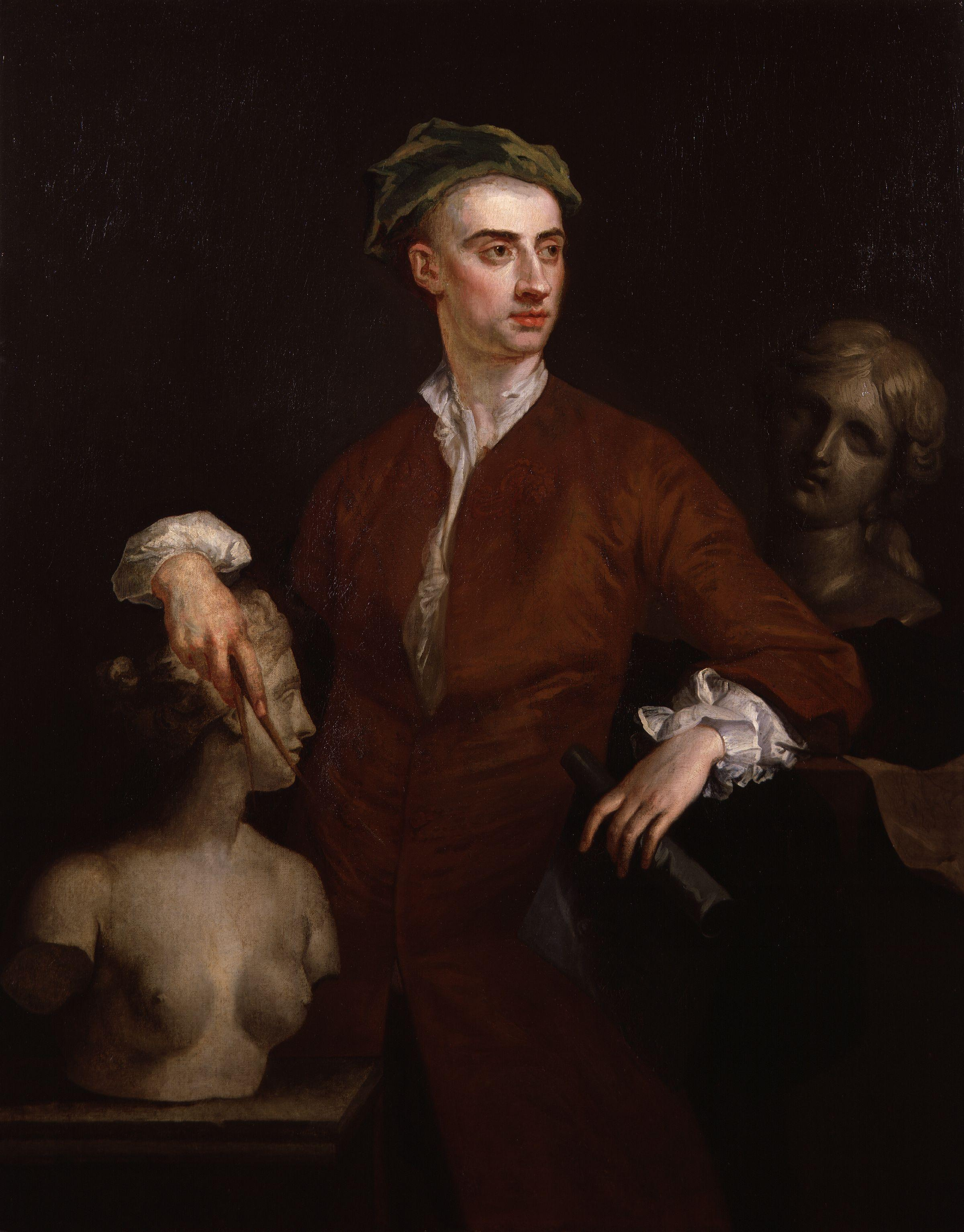|
Clandon Park House
Clandon Park House is an early 18th-century grade I listed Palladian mansion in West Clandon, near Guildford in Surrey. It stands in the south east corner of Clandon Park, a agricultural parkland estate which has been the seat of the Earls of Onslow for over two centuries. The house and gardens were given to the National Trust in 1956, but the park remains in private ownership. Some of the house's contents have also been acquired by the Trust in lieu of estate duty. Construction of the house, designed by Italian architect Giacomo Leoni, began about 1730, and the interiors were finished by continental sculptors and plasterers in the 1740s. It replaced an Elizabethan house. The park was landscaped by Lancelot 'Capability' Brown in 1781, and there are two formal gardens on either side of the house. On the Epsom Road, leading to the park and house, are the Grade II* 18th century wrought iron gates with armorial overthrow, which Brown installed, and the gatehouses (1776), designed ... [...More Info...] [...Related Items...] OR: [Wikipedia] [Google] [Baidu] |
Parterre
A ''parterre'' is a part of a formal garden constructed on a level substrate, consisting of symmetrical patterns, made up by plant beds, low hedges or coloured gravels, which are separated and connected by paths. Typically it was the part of the garden nearest the house, perhaps after a terrace. The view of it from inside the house, especially from the upper floors, was a major consideration in its design. The word "parterre" was and is used both for the whole part of the garden containing parterres and for each individual section between the "alleys". The pattern or the borders of the beds may be marked by low, tightly pruned, evergreen hedging, and their interiors may be planted with flowers or other plants or filled with mulch or gravel. Parterres need not have any flowers at all, and the originals from the 17th and 18th centuries had far fewer than modern survivals or reconstructions. Statues or small evergreen trees, clipped as pyramids or other shapes, often marked ... [...More Info...] [...Related Items...] OR: [Wikipedia] [Google] [Baidu] |
Merrow, Surrey
The village of Merrow, in Surrey, England in the 21st century constitutes the north-east suburb of Guildford. It is however centred from the town centre, right on the edge of the ridge of hills that forms the North Downs. Although now a relatively obscure suburb, the village can trace its origins back many hundreds of years. According to the Institute for Name-Studies, Merrow means 'fat', literally, "probably referring to the high fertility of the land". Merrow is separated from Burpham (to the north-west) by the New Guildford Line, the second railway line between Guildford and London. History The village grew up around a crossroads: where what is now the A25, the road between Guildford and Leatherhead, crossed the original road (''Merrow Street'') from Burpham to Dorking. The oldest houses in the village can still be seen along these two roads, together with St John's Church and the ''Horse and Groom'', a 17th-century coaching inn next door. The old Dorking road squeezes ... [...More Info...] [...Related Items...] OR: [Wikipedia] [Google] [Baidu] |
Dutch Garden
Dutch garden refers firstly to gardens in the Netherlands, but also, mainly in the English-speaking countries, to various types of gardens traditionally considered to be in a Dutch style, a presumption that has been much disputed by garden historians in recent decades. Historically gardens in the Netherlands have generally followed trends from neighbouring countries, but from the Early Modern period, Dutch gardens were distinctive for the wider range of plants available over the rest of Europe north of the Alps, and an emphasis on individual specimen plants, often sparsely planted in a bed. In the 17th century and into the 18th, the Dutch dominated the publishing of botanical books, and established the very strong position in the breeding and growing of garden plants, which they still retain. They were perhaps also distinguished by their efficient use of space, and in large examples, the use of topiary (sculptured bushes and trees) and small " canals", long thin, rectangular arti ... [...More Info...] [...Related Items...] OR: [Wikipedia] [Google] [Baidu] |
Porte-cochère
A porte-cochère (; , late 17th century, literally 'coach gateway'; plural: porte-cochères, portes-cochères) is a doorway to a building or courtyard, "often very grand," through which vehicles can enter from the street or a covered porch-like structure at a main or secondary entrance to a building through which originally a horse and carriage and today a motor vehicle can pass to provide arriving and departing occupants protection from the elements. Portes-cochères are still found on such structures as major public buildings and hotels, providing covered access for visitors and guests arriving by motorized transport. A porte-cochère, a structure for vehicle passage, is to be distinguished from a portico, a columned porch or entry for human, rather than vehicular, traffic. History The porte-cochère was a feature of many late 18th- and 19th-century mansions and public buildings. A well-known example is at Buckingham Palace in London. A portico at the White House in ... [...More Info...] [...Related Items...] OR: [Wikipedia] [Google] [Baidu] |
Rococo
Rococo (, also ), less commonly Roccoco or Late Baroque, is an exceptionally ornamental and theatrical style of architecture, art and decoration which combines asymmetry, scrolling curves, gilding, white and pastel colours, sculpted moulding, and '' trompe-l'œil'' frescoes to create surprise and the illusion of motion and drama. It is often described as the final expression of the Baroque movement. The Rococo style began in France in the 1730s as a reaction against the more formal and geometric Louis XIV style. It was known as the "style Rocaille", or "Rocaille style". It soon spread to other parts of Europe, particularly northern Italy, Austria, southern Germany, Central Europe and Russia. It also came to influence the other arts, particularly sculpture, furniture, silverware, glassware, painting, music, and theatre. Although originally a secular style primarily used for interiors of private residences, the Rococo had a spiritual aspect to it which led to its widespread us ... [...More Info...] [...Related Items...] OR: [Wikipedia] [Google] [Baidu] |
Michael Rysbrack
Johannes Michel or John Michael Rysbrack, original name Jan Michiel Rijsbrack, often referred to simply as Michael Rysbrack (24 June 1694 – 8 January 1770), was an 18th-century Flemish sculptor, who spent most of his career in England where he was one of the foremost sculptors of monuments, architectural decorations and portraits in the first half of the 18th century. His style combined the Flemish Baroque with Classical influences. He operated an important workshop whose output left an important imprint on the practice of sculpture in England.Robert Williams and Katharine Eustace, ''Rysbrack family [Rysbraeck ' at Grove Art Online Accessed 25 March 2021 Family background and early life Rysbrack was born on 24 June 1694 in[...More Info...] [...Related Items...] OR: [Wikipedia] [Google] [Baidu] |
Clandon House 1824 Engraving
Places called Clandon in Surrey, England: * East Clandon East Clandon is a village and civil parish in Surrey, England on the A246 between the towns of Guildford to the west and Leatherhead to the east. Neighbouring villages include West Clandon and West Horsley. In 2011 it had a population of 26 ... * West Clandon * Clandon Park, 18th century Palladian mansion in West Clandon * Clandon railway station {{Disambig, geodis ... [...More Info...] [...Related Items...] OR: [Wikipedia] [Google] [Baidu] |
House Of Commons Of The United Kingdom
The House of Commons is the lower house of the Parliament of the United Kingdom. Like the upper house, the House of Lords, it meets in the Palace of Westminster in London, England. The House of Commons is an elected body consisting of 650 members known as members of Parliament (MPs). MPs are elected to represent constituencies by the first-past-the-post system and hold their seats until Parliament is dissolved. The House of Commons of England started to evolve in the 13th and 14th centuries. In 1707 it became the House of Commons of Great Britain after the political union with Scotland, and from 1800 it also became the House of Commons for Ireland after the political union of Great Britain and Ireland. In 1922, the body became the House of Commons of the United Kingdom of Great Britain and Northern Ireland after the independence of the Irish Free State. Under the Parliament Acts 1911 and 1949, the Lords' power to reject legislation was reduced to a delaying power. The ... [...More Info...] [...Related Items...] OR: [Wikipedia] [Google] [Baidu] |
Speaker Of The House Of Commons (United Kingdom)
The speaker of the House of Commons is the presiding officer of the House of Commons, the lower house and primary chamber of the Parliament of the United Kingdom. The current speaker, Sir Lindsay Hoyle, was elected Speaker on 4 November 2019, following the retirement of John Bercow. Hoyle began his first full parliamentary term in the role on 17 December 2019, having been unanimously re-elected after the 2019 general election. The speaker presides over the House's debates, determining which members may speak and which amendments are selected for consideration. The speaker is also responsible for maintaining order during debate, and may punish members who break the rules of the House. Speakers remain strictly non-partisan and renounce all affiliation with their former political parties when taking office and afterwards. The speaker does not take part in debate or vote (except to break ties; and even then, the convention is that the speaker casts the tie-breaking vote acc ... [...More Info...] [...Related Items...] OR: [Wikipedia] [Google] [Baidu] |
Arthur Onslow
Arthur Onslow (1 October 169117 February 1768) was an English politician. He set a record for length of service when repeatedly elected to serve as Speaker of the House of Commons, where he was known for his integrity. Early life and education Onslow was born in Kensington, the elder son of Foot Onslow (died 1710) and his wife Susannah née Anlaby. He was educated at The Royal Grammar School, Guildford, and Winchester College and matriculated at Wadham College, Oxford, in 1708, although he took no degree. He was called to the bar at the Middle Temple in 1713, but had no great practice in law. Career When George I came to the throne, Onslow's uncle Sir Richard Onslow was appointed Chancellor of the Exchequer. Arthur became his private secretary. When Richard left office in 1715, Arthur obtained a place as receiver general of the Post Office. He became Recorder of Guildford in 1719. As his Post Office position was not compatible with a parliamentary seat, he passe ... [...More Info...] [...Related Items...] OR: [Wikipedia] [Google] [Baidu] |
Thomas Onslow, 2nd Baron Onslow
Thomas Onslow, 2nd Baron Onslow (27 November 1679 – 5 June 1740), of West Clandon, Surrey, was a British landowner and Whig politician who sat in the English and British House of Commons between 1702 and 1717. He commissioned the building of Clandon Park House in the 1730s. Early life Onslow was the only surviving son of Richard Onslow, 1st Baron Onslow. He was educated at Eton College from 1691 to 1693, and the travelled abroad in Holland and France from 1697 to 1698. He married Elizabeth Knight, the daughter of John Knight, a merchant of Jamaica, and niece of Colonel Charles Knight, and was heir to both their fortunes. Political career He represented a continuous succession of constituencies in the Parliament of England and Great Britain. He first entered Parliament in 1702, aged 22 or 23, as the MP for Gatton, Surrey, an underpopulated rural borough that had once had a market in the medieval period. He was then returned in 1705 to represent the larger settlement of Ch ... [...More Info...] [...Related Items...] OR: [Wikipedia] [Google] [Baidu] |
Long Parliament
The Long Parliament was an English Parliament which lasted from 1640 until 1660. It followed the fiasco of the Short Parliament, which had convened for only three weeks during the spring of 1640 after an 11-year parliamentary absence. In September 1640, King Charles I issued writs summoning a parliament to convene on 3 November 1640.This article uses the Julian calendar with the start of year adjusted to 1 January – for a more detailed explanation, see old style and new style dates: differences between the start of the year. He intended it to pass financial bills, a step made necessary by the costs of the Bishops' Wars in Scotland. The Long Parliament received its name from the fact that, by Act of Parliament, it stipulated it could be dissolved only with agreement of the members; and those members did not agree to its dissolution until 16 March 1660, after the English Civil War and near the close of the Interregnum.. The parliament sat from 1640 until 1648, when it was pu ... [...More Info...] [...Related Items...] OR: [Wikipedia] [Google] [Baidu] |










